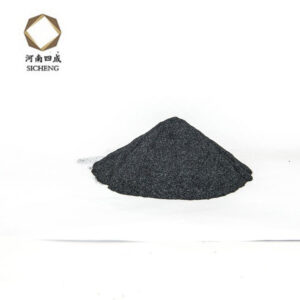What is the difference between green SiC and black SiC?
In the vast field of materials science, silicon carbide (SiC), as a high-performance non-metallic material, plays an important role in many industries with its unique physical and chemical properties. Among them, green silicon carbide and black silicon carbide are the two main varieties of silicon carbide. Although they both belong to the basic category of α-SiC, they show significant differences in production processes, physical and chemical properties, and application fields. This article will delve into the differences between these two types of silicon carbide so readers can better understand their properties and applications.
1. Differences in production processes
The production process of green silicon carbide is unique. It mainly uses petroleum coke and high-quality silica as the main raw materials, and adds salt as an additive, and is smelted at high temperature in a resistance furnace. During this process, the addition of salt not only promotes the crystallization process of silicon carbide, but also significantly improves the purity and crystallization quality of the product. In contrast, the production of black silicon carbide relies on a combination of quartz sand, petroleum coke and high-quality silica, which is also smelted at high temperatures in a resistance furnace, but does not involve the addition of salt. Therefore, from the perspective of raw material ratio and process, the preparation of green silicon carbide is more complex and sophisticated, which also lays the foundation for its subsequent performance.
2. Differences in physical and chemical properties
In terms of physical and chemical properties, both green silicon carbide and black silicon carbide exhibit extremely high hardness and mechanical strength. Their hardness is between corundum and diamond, far exceeding that of ordinary metal materials. However, the crystalline purity of green silicon carbide is higher, which gives it an advantage in certain properties. For example, the tensile strength and compressive strength of green silicon carbide are very high, even several times higher than high-strength steel, showing excellent mechanical properties. At the same time, green silicon carbide also has excellent high temperature resistance, its melting point is as high as over 2700°C, and it can still maintain stable physical and chemical properties in high temperature environments. In addition, green silicon carbide also has excellent chemical stability and can withstand the erosion of a variety of strong acids, strong alkali and organic solvents, which makes it have broad application prospects in chemical industry, electronics, medical and other fields.
In contrast, although black silicon carbide also has the characteristics of high hardness, high strength and high wear resistance, its toughness is slightly higher than that of green silicon carbide, which to a certain extent affects its self-sharpening during processing. . However, black silicon carbide has a moderate density (about 3.15-3.21g/cm³), a high thermal conductivity, and good oxidation resistance and radiation resistance. These characteristics make it widely used in alumina kilns, grates, and refractory ceramics. It is widely used in high temperature and high oxidation environments.
3. Differences in application fields
Due to differences in physical and chemical properties, green silicon carbide and black silicon carbide also have different application fields. Green silicon carbide is widely used for precision grinding and crystal wire cutting of cemented carbide, quartz glass, optical glass and other materials due to its high purity, high hardness and excellent mechanical properties. Especially in the field of semiconductor material processing, green silicon carbide powder is an important raw material for the production of monocrystalline silicon and polycrystalline silicon cutting wafers. Its grain size and purity directly affect cutting quality and efficiency. In addition, green silicon carbide is used in high-temperature and highly corrosive environments such as aerospace engines, gas turbines, and chemical equipment because of its good high-temperature resistance and chemical stability.
Black silicon carbide, because of its high toughness and good wear resistance, performs well in grinding alloys, ceramics, marble, jade and other materials. At the same time, black silicon carbide is also used to make high-hardness, wear-resistant tools and parts, such as abrasives, grinding wheels, cutting discs, etc. In the field of ceramics, black silicon carbide can be combined with other ceramic materials to prepare high-performance composite ceramic materials to meet specific engineering needs. In addition, black silicon carbide is also widely used in refractory materials, aerospace, automobile manufacturing and other fields.
4. Price and market trends
The prices of green silicon carbide and black silicon carbide are affected by many factors such as market demand, origin, quality, etc., and the prices fluctuate greatly. Generally speaking, because the production process of green silicon carbide is more complex and the product performance is better, its price is relatively high. However, with the continuous advancement of technology and the reduction of production costs, the market competitiveness of green silicon carbide is also increasing. At the same time, as the global demand for high-performance materials continues to grow, the market prospects for green silicon carbide and black silicon carbide are very broad.
5. Conclusion
In summary, green silicon carbide and black silicon carbide, as the two main varieties of silicon carbide, have significant differences in production processes, physical and chemical properties, and application fields. Green silicon carbide occupies an important position in semiconductor material processing, high-temperature equipment and other fields because of its high purity, high hardness and excellent mechanical properties; while black silicon carbide plays an important role in alloys, ceramics and other materials due to its high toughness and wear resistance. Plays an important role in grinding. In the future, with the continuous advancement of science and technology and the continuous expansion of application fields, the properties of green silicon carbide and black silicon carbide will be more explored and applied, contributing more to the development of materials science.


